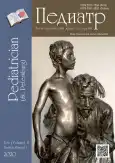Diagnostic problems of hirschsprung’s disease in neonates: clinical examples
- Authors: Kagan A.V.1,2, Kotin A.N.1, Karavaeva S.A.3, Kesaeva T.V.3
-
Affiliations:
- Pavlov First Saint Petersburg State Medical University
- Children’s City Multidisciplinary Clinical Specialized Center of High Medical Technologies
- North-Western State Medical University named after I.I. Mechnikov
- Issue: Vol 11, No 1 (2020)
- Pages: 83-90
- Section: Clinical observation
- URL: https://journals.rcsi.science/pediatr/article/view/33860
- DOI: https://doi.org/10.17816/PED11183-90
- ID: 33860
Cite item
Full Text
Abstract
Hirschsprung’s disease usually manifests from the first days of life and is diagnosed in the newborn period. In some patients Hirschsprung’s disease can’t be diagnosed in the newborn period because of different forms of disease and clinical features. From 2008 to 2019 75 patients with Hirschsprung’s disease were operated in the City Children’s Hospital No. 1. 21 patients had delayed diagnosis. 11 newborns didn’t have very clear clinical symptoms, intestinal obstruction disappeared after decompression. 2 patients with associated chromosomal disorders were diagnosed with Hirschsprung’s disease later because of. In some of older patients disease manifested with severe constipations. Also, we presented some clinical cases of major diagnostic errors in patients with Hirschsprung’s disease. Conclusion. Diagnostic errors in patients with Hirschsprung’s disease are associated with the lack of alertness of neonatologists and inadequate interpretation of clinical manifestations and X-ray study. For many years these children can be treated by different specialists before having surgical consult.
Full Text
##article.viewOnOriginalSite##About the authors
Anatoly V. Kagan
Pavlov First Saint Petersburg State Medical University; Children’s City Multidisciplinary Clinical Specialized Center of High Medical Technologies
Author for correspondence.
Email: childone@dgb.spb.ru
MD, PhD, Dr Med Sci, Professor, Head, Faculty of Pediatric Surgery
Russian Federation, Saint PetersburgAleksey N. Kotin
Pavlov First Saint Petersburg State Medical University
Email: nicolasr@mail.ru
MD, PhD, Associate Professor, Faculty of Pediatric Surgery
Russian Federation, Saint PetersburgSvetlana A. Karavaeva
North-Western State Medical University named after I.I. Mechnikov
Email: swetl.karawaewa2015@yandex.ru
MD, PhD, Dr Med Sci, Professor, Head, Faculty of Pediatric Surgery
Russian Federation, Saint PetersburgTamara V. Kesaeva
North-Western State Medical University named after I.I. Mechnikov
Email: tomo4ka13@mail.ru
Postgraduate Student, Faculty of Pediatric Surgery
Russian Federation, Saint PetersburgReferences
- Медведева Н.Н., Нуртазина Г.К., Торопеева В.С., и др. Клинико-инструментальные аспекты диагностики болезни Гиршпрунга у детей // Клиническая медицина Казахстана. – 2012. – T. 26. – № 4. – C. 70–71. [Medvedeva NN, Nurtazina GK, Toropeeva VS, et al. Kliniko-instrumental’nye aspekty diagnostiki bolezni Girshprunga u detey. Klinicheskaya meditsina Kazakhstana. 2012;26(4):70-71. (In Russ.)]
- Сварич В.Г., Киргизов И.В Наш опыт лечения болезни Гиршпрунга у детей // Детская хирургия. – 2016. – Т. 20. – № 5. – С. 264–268. [Svarich VG, Kirgizov IV. Our experience with the treatment of Hirschsprung disease in children. Pediatric surgery. 2016;20(5): 264-268. (In Russ.)] https://doi.org/10.18821/1560-9510-2016-20-5-264-268.
- de Lorijn F, Boeckxstaens GE, Benninga MA. Symptomatology, pathophysiology, diagnostic work-up, and treatment of Hirschsprung disease in infancy and childhood. Curr Gastroenterol Rep. 2007;9(3):245-253. https://doi.org/10.1007/s11894-007-0026-z.
- Diamond IR, Casadiego G, Traubici J, et al. The contrast enema for Hirschsprung disease: predictors of a false-positive result. J Pediatr Surg. 2007;42(5):792-795. https://doi.org/10.1016/j.jpedsurg.2006.12.031.
- Gross ER, Geddes GC, McCarrier JA, et al. Skip segment Hirschsprung disease and Waardenburg syndrome. J Pediatr Surg Case Rep. 2015;3(4):143-145. https://doi.org/10.1016/j.epsc.2015.02.005.
- Holschneider AM, Puri P. Hirschsprung’s Disease and Allied Disorders. 3rd ed. Berlin, Heidelberg: Springer; 2008.
- Jafarshad R, Izadi M, Mansour-Ghanaei F, et al. Clinical Manifestations of Hirschsprung’s Disease: A Six Year Course Review of Admitted Patients in Gilan, Northern Iran. Middle East J Dig Dis. 2009;1(2):68-73.
- Moore SW, Zaahl M. Familial associations in medullary thyroid carcinoma with Hirschsprung disease: the role of the RET-C620 «Janus» genetic variation. J Pediatr Surg. 2010;45(2):393-396. https://doi.org/10.1016/j.jpedsurg.2009.10.080.
- Moore SW. Genetic impact on the treatment & management of Hirschsprung disease. J Pediatr Surg. 2017;52(2):218-222. https://doi.org/10.1016/j.jpedsurg.2016.11.012.
- Noviello C, Cobellis G, Romano M, et al. Diagnosis of Hirschsprung’s Disease: an age-related approach in children below or above one year. Colorectal Dis. 2010;12(10):1044-1048. https://doi.org/10.1111/j.1463-1318.2009.01940.x.
- Park J. Delayed diagnosis of Hirschsprung’s disease associated with colonic atresia and multiple anomalies: Report of a case and review of the literature. J Pediatr Surg Case Rep. 2016;10:20-22. https://doi.org/10.1016/j.epsc.2016.04.021.
- Lai FP, Lau ST, Wong JK, et al. Correction of Hirschsprung-Associated Mutations in Human Induced Pluripotent Stem Cells Via Clustered Regularly Interspaced Short Palindromic Repeats/Cas9, Restores Neural Crest Cell Function. Gastroenterology. 2017;153(1):139-153 e138. https://doi.org/10.1053/j.gastro.2017.03.014.
- Rajab A, Freeman NV, Patton MA. Hirschsprung’s disease in Oman. J Pediatr Surg. 1997;32(5):724-727. https://doi.org/10.1016/s0022-3468(97)90015-4.
- Chia ST, Chen SC, Lu CL, et al. Epidemiology of Hirschsprung’s Disease in Taiwanese Children: A 13-year Nationwide Population-based Study. Pediatr Neonatol. 2016;57(3):201-206. https://doi.org/10.1016/j.pedneo.2015.04.016.
- Singh SJ, Croaker GD, Manglick P, et al. Hirschsprung’s disease: the Australian Paediatric Surveillance Unit’s experience. Pediatr Surg Int. 2003;19(4):247-250. https://doi.org/10.1007/s00383-002-0842-z.
- Torfs P.C. An epidemiological study of Hirschsprung’s disease in a multiracial California population. In: Proceedings of the 3rd International Meeting: Hirschsprung’s Disease and Related Neurocristopathies; 1998, Evian, France.
- Wetherill C, Sutcliffe J. Hirschsprung disease and anorectal malformation. Early Hum Dev. 2014;90(12):927-932. https://doi.org/10.1016/j.earlhumdev.2014.09.016.
Supplementary files















